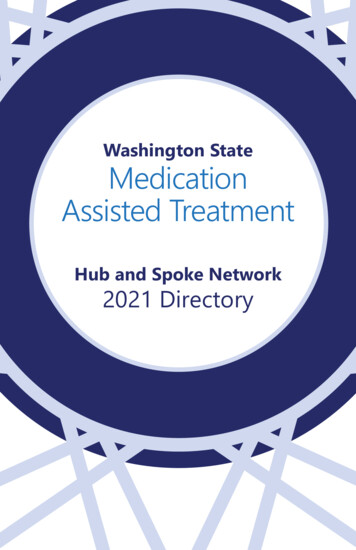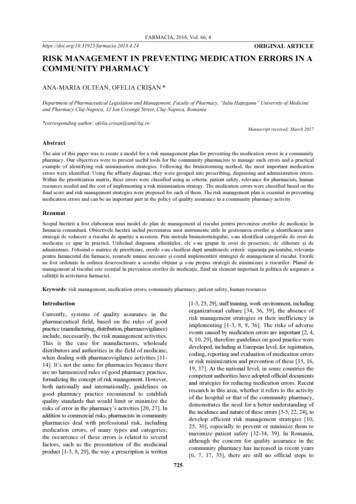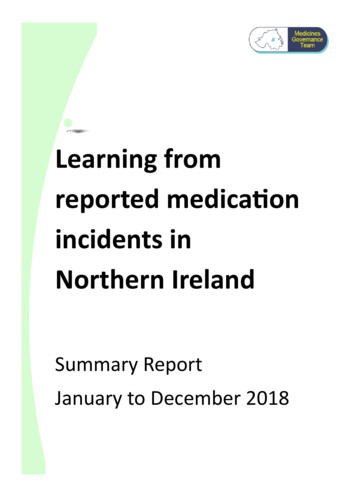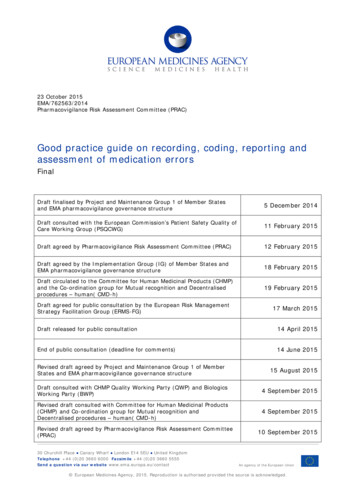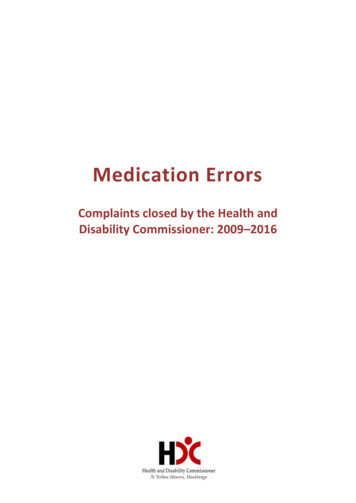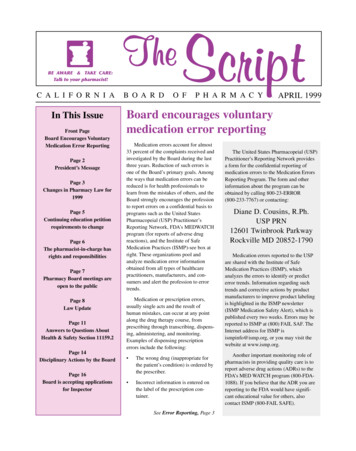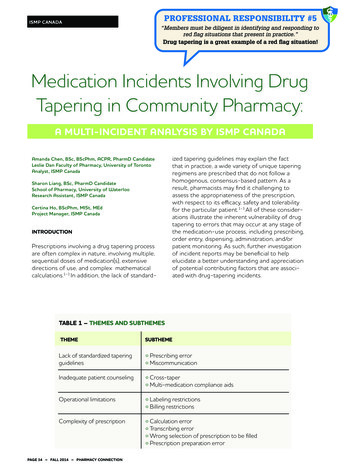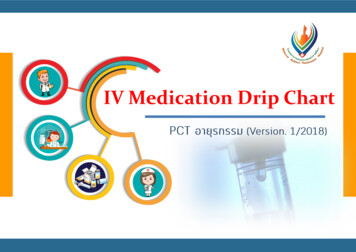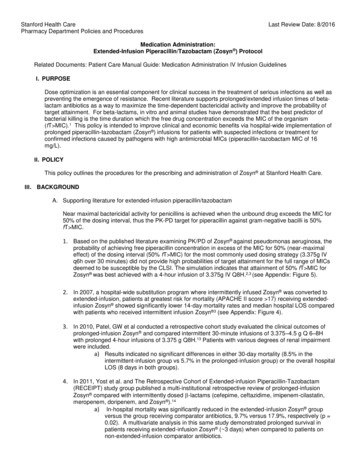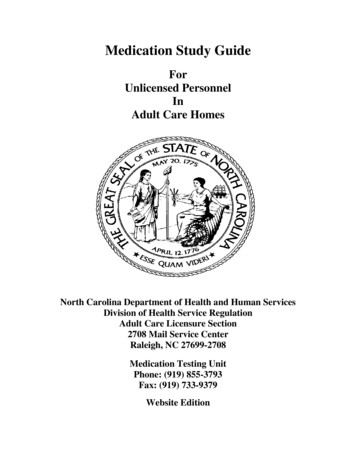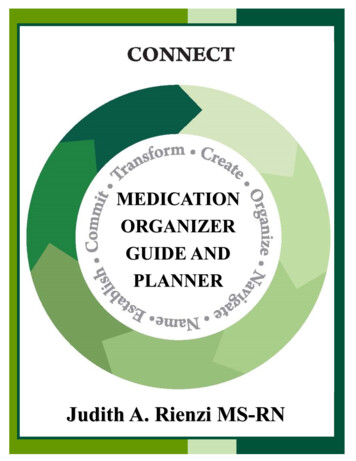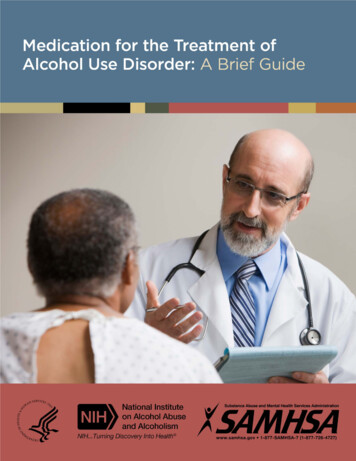
Transcription
Medication for the Treatment ofAlcohol Use Disorder:A Brief GuideU.S. Department of Health and Human ServicesSubstance Abuse and Mental Health Services AdministrationCenter for Substance Abuse TreatmentDivision of Pharmacologic Therapies1 Choke Cherry RoadRockville, MD 20857
AcknowledgmentsThis publication was prepared for the Substance Abuse and Mental Health Services Administration(SAMHSA) by JBS International, Inc. under contract number HHSS283200700003I/HHSS28342007T,with SAMHSA, U.S. Department of Health and Human Services (HHS). CDR Alina Salvatore, R.Ph.,M.S., and LCDR Brandon T. Johnson, M.B.A., served as the Contracting Officer Representatives.DisclaimerThe views, opinions, and content expressed herein are the views of the authors and do not necessarilyreflect the official position of SAMHSA, the National Institute on Alcohol Abuse and Alcoholism (NIAAA)or HHS. Nothing in this document constitutes an indirect or direct endorsement by SAMHSA, NIAAA, orHHS of any non-federal entity’s products, services, or policies and any reference to a non-federalentity’s products, services, or policies should not be construed as such. No official support of orendorsement by SAMHSA, NIAAA, or HHS for the opinions, resources, and medications described isintended to be or should be inferred. The information presented in this document should not beconsidered medical advice and is not a substitute for individualized patient or client care and treatmentdecisions.Public Domain NoticeAll materials appearing in this volume except those taken directly from copyrighted sources are in thepublic domain and may be reproduced or copied without permission from SAMHSA or the authors.Citation of the source is appreciated. However, this publication may not be reproduced or distributed fora fee without the specific, written authorization of the Office of Communications, SAMHSA, HHS.Electronic Access and Printed CopiesThis publication may be downloaded or ordered at http://store.samhsa.gov. Or call SAMHSA at 1 877-SAMHSA-7 (1-877-726-4727) (English and Español).Recommended CitationSubstance Abuse and Mental Health Services Administration and National Institute on Alcohol Abuseand Alcoholism, Medication for the Treatment of Alcohol Use Disorder: A Brief Guide. HHS PublicationNo. (SMA) 15-4907. Rockville, MD: Substance Abuse and Mental Health Services Administration,2015.Originating OfficeDivision of Pharmacologic Therapies, Center for Substance Abuse Treatment, Substance Abuse andMental Health Services Administration, 1 Choke Cherry Road, Rockville, MD 20857. HHS PublicationNo. (SMA) 15-4907. Printed 2015.i
Medication for the Treatment of Alcohol Use Disorder: A Brief GuideCONTENTSIntroduction .1Considering Medications .2Screening and Assessing Patients .7Screening for Risky Alcohol Use .7Assessing the Need for Medication-Assisted Treatment.7Developing a Treatment Plan and Selecting a Medication.9Setting Goals for Medication-Assisted Treatment .9Components of the Treatment Plan .9Educating the Patient and Obtaining Informed Consent .9Evaluating the Need for Medically Managed Detoxification .10Integrating Pharmacologic and Nonpharmacologic Therapies .11Addressing Co-Occurring Disorders .11Treating Adolescents and Young Adults .12Treating Pregnant and Postpartum Women.12Treating Older Adults .12Selecting a Medication .13Medication-Assisted Treatment .18Initiating Treatment with Disulfiram .18Initiating Treatment with Naltrexone.18Initiating Treatment with Acamprosate .20Treating People with Co-Occurring Disorders .20Monitoring Patient Progress .20Monitoring . 20Adjusting the Treatment Plan .21Summary . 23Appendix A: Members of the Consensus Panel, Staff, and Consultants .24Appendix B: Sources of Helpful Information .26Appendix C: Acknowledgments .29References . 30ii
Medication for the Treatment of Alcohol Use Disorder: A Brief GuideINTRODUCTIONCurrent evidence shows that medications areunderused in the treatment of alcohol usedisorder, including alcohol abuse anddependence.* This is of concern because of thehigh prevalence of alcohol problems in thegeneral population.1,2 For example, data showthat an estimated 10 percent to 20 percent ofpatients seen in primary care or hospitalsettings have a diagnosable alcohol usedisorder.3,4 People who engage in risky drinkingoften have physical and social problems relatedto their alcohol use. Problems with alcoholinfluence the incidence, course, and treatmentof many other medical and psychiatricconditions.2Yet, of the 18.0 million people who met thecriteria for alcohol dependence or abuse in2013, only a small subset (1.4 million) receivedany type of formal treatment (excluding mutualhelp groups)—ranging from a single meetingwith a counselor to participation in a specializedtreatment program.3Although many experts in addiction believe thatpatients with moderate or severe alcoholrelated problems should be offered medicationassisted treatment (MAT) on a routine basis,1considerable resistance to the use of MATpersists. A diagnosis of alcohol use disordercontinues to carry significant social exclusion,which affects both the individual who receivesthe diagnosis and the health care professionalsto whom that individual may turn for care. Inpart, the social exclusion continues because ofa lack of understanding of alcohol use disorderas a treatable medical disorder2 even though,more than 50 years ago, the American MedicalAssociation (AMA) affirmed that dependence onalcohol and other drugs is a medical disorder.5The AMA encouraged physicians and otherclinicians, health care organizations, andpolicymakers to frame all their activities anddecisions in ways that reflect that fact.*Within this document “alcohol abuse” and “alcoholdependence” are used when discussing medication indicationsor research that is based upon this terminology. For a summaryof important differences between DSM-IV and DSM-5, pleasesee the box on this page.Alcohol Use Disorder: A ComparisonBetween DSM-IV and DSM-5“In May 2013, the American PsychiatricAssociation issued the 5th edition of theDiagnostic and Statistical Manual of MentalDisorders (DSM-5). Although there isconsiderable overlap between DSM-5 andDSM-IV, the prior edition, there are severalimportant differences: DSM–IV described twodistinct disorders, alcohol abuse and alcoholdependence, with specific criteria for each.DSM-5 integrates the two DSM-IV disorders,alcohol abuse and alcohol dependence, into asingle disorder called alcohol use disorder(AUD) with mild, moderate, and severesubclassifications. Under DSM-5, anyonemeeting any two of the 11 criteria during thesame 12-month period would receive adiagnosis of AUD. The severity of an AUD—mild, moderate, or severe—is based on thenumber of criteria met: Mild: The presence of 2 to 3 symptomsModerate: The presence of 4 to 5symptomsSevere: The presence of 6 or moresymptomsThe DSM-5 eliminates legal problems as acriterion, adds craving as a criterion for an AUDdiagnosis and modifies some of the criteriadescriptions with updated language.”––National Institute on Alcohol6Abuse and AlcoholismTo clarify the situation, the National Institute onAlcohol Abuse and Alcoholism (NIAAA) and theSubstance Abuse and Mental Health ServicesAdministration (SAMHSA) jointly convened aConsensus Panel on New and EmergingPharmacotherapies for Alcohol Use Disordersand Related Comorbidities (see Appendix A).The panel, which brought together experts inalcohol research, clinical care, medicaleducation, and public policy, reviewed currentevidence on the effectiveness of availablemedications for the treatment of alcohol usedisorders and developed guidance for the useof medications in clinical practice.1 The panel’sguidance is summarized in this document.1
Medication for the Treatment of Alcohol Use Disorder: A Brief GuideCONSIDERING MEDICATIONSDirect involvement of physicians and other healthcare professionals in identifying and treatingalcohol use disorder is possible, practical, andnecessary. The medications described here havebeen shown to be effective in, and are approvedby the Food and Drug Administration (FDA) for,the management of alcohol dependence or theprevention of relapse to alcohol use.7,8,9,10,11Specifically: Acamprosate calcium is indicated for themaintenance of abstinence from alcohol inpatients dependent on alcohol who areabstinent at treatment initiation. Disulfiram is an aid in the management ofselected patients who want to remain in astate of enforced sobriety so that supportiveand psychotherapeutic treatment may beapplied to best advantage. Oral naltrexone (naltrexone hydrochloridetablet) is indicated for the treatment of alcoholdependence. Extended-release injectable naltrexone isindicated for the treatment of alcoholdependence in patients who have been ableto abstain from alcohol in an outpatientsetting.2Clinicians should consider prescribing one ofthese medications when treating a patient who isdependent on alcohol or who has stoppeddrinking but is experiencing problems includingcravings or relapses. Patients with moderate orsevere alcohol use disorder, including those whohave physiologic dependence or who areexperiencing cravings and have not improved inresponse to psychosocial approaches alone, areparticularly strong candidates for medicationassisted treatment.1,2Medications should be prescribed as part of acomprehensive treatment approach that includescounseling and other psychosocial therapies(through referral to a psychiatrist, psychologist, orprofessional counselor) and social supports(through participation in Alcoholics Anonymousand other mutual-help programs).1,2Table 1 summarizes information about eachmedication approved by the FDA for thetreatment of alcohol use disorder and/or theprevention of relapse to alcohol use.
Medication for the Treatment of Alcohol Use Disorder: A Brief GuideTABLE 1: Medications Approved for Use in the Treatment of Alcohol Use Disorder†DisulfiramNaltrexoneoral and extended-release injectableformulationsAcamprosatedelayed-release tabletsFrequency ofAdministrationDailyDaily (oral) or monthly (extended-releaseinjectable)Three times per dayPrincipal ActionWhen taken in combination with alcohol,causes a significant physical reaction,involving nausea/vomiting, flushing, andheart palpitations. The knowledge that suchreactions are likely if alcohol is consumedacts as a deterrent to drinking.Blocks opiate receptors that are involved in therewarding effects of drinking and craving foralcohol.Is thought to reduce symptoms of protractedabstinence by counteracting the imbalancebetween the glutamatergic and GABAergicsystems associated with chronic alcoholexposure and alcohol withdrawal.Given sufficient amounts of alcohol in thepatient’s system, more severe reactionsmay occur, such as respiratory depression,cardiovascular collapse, arrhythmias,myocardial infarction, acute congestiveheart failure, unconsciousness,convulsions, and death.ClinicalUses/IdealCandidatesCandidates include patients dependent onalcohol who have completed alcoholwithdrawal. Ideally, candidates arecommitted to abstinence and willing to takedisulfiram under the supervision of a familymember or treatment program.Extended-release injectable naltrexone isadministered every 4 weeks, thereby minimizingopportunities for nonadherence, as compared withdaily oral ingestion. The monthly injection alsoproduces a more consistent and predictable bloodlevel of the drug, because the depot injectionbypasses first-pass metabolism.Oral naltrexone and extended-release injectablenaltrexone are indicated for the treatment ofalcohol dependence in patients who can abstainfrom alcohol in an outpatient setting before theinitiation of treatment. Naltrexone has not beenshown to be effective in patients who are drinkingat treatment initiation.Both formulations may have the greatest benefit inpatients who can discontinue drinking on their ownfor several days before treatment initiation.Acamprosate is indicated for themaintenance of abstinence in patients whoare dependent on alcohol and are abstinentat treatment initiation.The efficacy of acamprosate in promotingabstinence has not been demonstrated insubjects who have not completeddetoxification or who have not achievedalcohol abstinence before beginningtreatment.Extended-release injectable naltrexone is alsoindicated for the prevention of relapse to opioiddependence following detoxification.†This table highlights some properties of each medication. It does not provide complete information and is not intended as a substitute for the package inserts or other drug reference sourcesused by clinicians (see http://www.dailymed.nlm.nih.gov for current package inserts). For patient information about these and other drugs, visit the National Library of Medicine’s MedlinePlus(http://www.medlineplus.gov). Whether a medication should be prescribed and in what amount are matters to be discussed between an individual and his or her health care provider. Theprescribing information provided here is not a substitute for the clinician’s judgment, and the National Institutes of Health and SAMHSA accept no liability or responsibility for use of theinformation in the care of individual patients.3
Medication for the Treatment of Alcohol Use Disorder: A Brief GuideDisulfiramContraindicationsContraindicated in the presence of severemyocardial disease or coronary occlusion,psychoses, pregnancy, and in those withhigh levels of impulsivity, suicidality, andhypersensitivity to disulfiram or to otherthiuram derivatives used in pesticides andrubber vulcanization.Patients who are taking or have recentlytaken metronidazole, paraldehyde, alcohol,or alcohol-containing preparations (e.g.,cough syrups, tonics) should not be givendisulfiram.Disulfiram labeling also includes severalimportant precautions regarding drug–druginteractions. See the package insert forspecific contraindications.Naltrexoneoral and extended-release injectableformulationsContraindicated in patients receiving opioidanalgesics and those receiving long-term opioidtherapy or anticipating a need for opioids (e.g.,surgery), because it could precipitate a severeopioid withdrawal or block opioid analgesia;patients currently dependent on opioids, includingthose being maintained on opioid agonists such asmethadone or partial agonists such asbuprenorphine; patients in acute opioid withdrawal;patients who have failed the naloxone challengetest or whose urine tests positive for opioids.Contraindicated in patients with a history ofsensitivity to polylactide-co-glycolide,carboxymethyl cellulose, or any components of thediluent used for the injectable medication.It should not be given to patients whose body massprecludes intramuscular (IM) injection with the 2 inch needle provided. Inadvertent subcutaneousinjection may cause a severe injection-sitereaction.Although not in current labeling, the consensus ofthe panel is that use should be avoided in patientswith serum aminotransferase levels greater thanfive times the upper limit of normal, except wherethe benefits outweigh the risks.4Acamprosatedelayed-release tabletsContraindicated in patients with severerenal impairment and in those who have aknown hypersensitivity to the drug or itscomponents.
Medication for the Treatment of Alcohol Use Disorder: A Brief GuideDisulfiramWarningsUse with caution in patients with heartdisease, diabetes, hypothyroidism,epilepsy, cerebral damage, chronic oracute nephritis, acute hepatitis or otherhepatic diseases, and in patients older than60.Hepatic toxicity (including hepatic failureresulting in liver transplantation or death)has been infrequently reported. Severe andsometimes fatal hepatitis associated withdisulfiram may develop after many monthsof therapy. Hepatic toxicity has occurred inpatients with or without a history ofabnormal liver function.Patients should be advised to immediatelynotify their physician of any earlysymptoms of hepatitis, including fatigue,weakness, malaise, anorexia, nausea,vomiting, jaundice, or dark urine.Liver function tests (taken at baseline and10–14 days later) are suggested to detectany hepatic dysfunction that may resultfrom disulfiram therapy. In addition,complete blood counts and serumchemistries, including liver function tests,should be monitored.Naltrexoneoral and extended-release injectableformulationsAcamprosatedelayed-release tabletsCases of hepatitis and clinically significant liverdysfunction were observed in association withextended-release injectable naltrexone treatment.Discontinue use of naltrexone in the event ofsymptoms or signs of acute hepatitis.Before initiating treatment withacamprosate, evaluate the patient’s renalfunction through a standard panel for urea,electrolytes, and serum creatinine to ruleout severe renal impairment.Use with caution in patients with moderate tosevere renal impairment.For patients with moderate renalimpairment (creatinine clearance of 30–50mL/min), a reduced dose of acamprosate(one 333 mg tablet 3 times a day) isrecommended.Patients should take no opioids, including opioidcontaining medications, for a minimum of 7 daysbefore starting naltrexone to avoid precipitatingopioid withdrawal.Patients needing opioid analgesia or patients witha history of opioid use disorder may respond tolower doses of opioids after treatment withextended-release injectable naltrexone. Failure tocarefully titrate opioid dose could result inpotentially life-threatening opioid intoxication andoverdose.Because of elevated risk of diminishedrenal function in people ages 65 or older,baseline and frequent renal function testsare important in this population.Patients should be told of the seriousconsequences of trying to overcome the opioidblockade.Psychotic reactions have been noted,attributable to the unmasking of underlyingpsychoses in patients.5
Medication for the Treatment of Alcohol Use Disorder: A Brief GuideDisulfiramUse in Pregnantand PostpartumWomenPregnancy: The FDA has not assigned apregnancy category. The safe use of thisdrug in pregnancy has not beenestablished. Therefore, disulfiram shouldbe used during pregnancy only when, inthe judgment of the physician, the probablebenefits outweigh the possible risks.Nursing: Do not give disulfiram to nursingmothers.Naltrexoneoral and extended-release injectableformulationsAcamprosatedelayed-release tabletsPregnancy: FDA Pregnancy Category C‡Pregnancy: FDA Pregnancy Category C‡Nursing: Transfer of naltrexone and 6ß-naltrexolinto human milk has been reported with oralnaltrexone. Because animal studies have shownthat naltrexone has a potential for tumorigenicityand other serious adverse reactions in nursinginfants, an individualized treatment decision shouldbe made whether a nursing mother will need todiscontinue breastfeeding or discontinuenaltrexone.Nursing: It is not known whetheracamprosate is excreted in human milk.SOURCE: SAMHSA and NIAAA. (2012, September). Report of the SAMHSA-NIAAA Consensus Panel on New and Emerging Pharmacotherapies for Alcohol UseDisorders and Related Comorbidities. Rockville, MD: SAMHSA.‡6Animal studies have shown an adverse effect on the fetus and there are no adequate, well-controlled studies in humans, but potential benefits may warrant use of the drug in some pregnantwomen despite potential risks.
Medication for the Treatment of Alcohol Use Disorder: A Brief GuideSCREENING AND ASSESSING PATIENTSClinicians should routinely screen their patients forat-risk drinking, provide brief interventions asneeded, and assess for alcohol use disorder whenindicated.2Screening for Risky Alcohol UseUniversal screening for alcohol problems can beconducted concurrently with screening for othermedical disorders as part of a routine examination.By systematically screening every patient with avalidated screening tool, the clinician can effectivelyidentify patients with risky or dependent levels ofalcohol use. This approach has been shown to besuperior to a case-finding approach.Screening also should be conducted beforeprescribing one of the many medications that mayinteract negatively with alcohol or if a patient reportsusing an over-the-counter product or herbalpreparation that may precipitate an adverse reaction.Screening is especially important in patients who: Are pregnant or trying to conceive. Are at risk for binge drinking or heavy drinking. Have health problems that may be induced orexacerbated by alcohol (e.g., cardiac arrhythmia,depression or anxiety, dyspepsia, insomnia, liverdisease, a history of traumatic injury). Have one or more chronic health problems (e.g.,diabetes, heart disease, hypertension,gastrointestinal [GI] disorders, chronic pain) thatare not responding to treatment.7 Have social or legal problems that may becaused or worsened by alcohol use (e.g.,marital/family issues, driving-while-under-theinfluence convictions).Screening can be conducted through use of asimple, validated self-report instrument such as theAlcohol Use Disorders Identification Test (AUDIT)(http://www.whqlibdoc.who.int/hq/2001/WHO MSD MSB 01.6a.pdf), which takes fewerthan 5 minutes to complete, or a single interviewquestion: “How many times in the past year haveyou had or more drinks in a day?” (five drinksfor men and four drinks for women). The singlequestion can be used at any time, either inconjunction with AUDIT or alone.7 Study resultshave shown that, when used in a primary caresetting, the single question was 82 percent sensitivein detecting individuals who had alcohol problems. 12A useful overview of screening and interventionstrategies can be found in a document calledAlcohol Misuse: Screening and BehavioralCounseling Interventions in Primary uspstf/uspsdrin.htm) (see Appendix B). ManyU.S. primary care physicians rely on these UnitedStates Preventive Services Task Forcerecommendations to guide how they conductpreventive practice. Clinicians should also considerusing Screening, Brief Intervention, and Referral toTreatment (SBIRT), an approach in which screeningis followed up as appropriate with brief intervention,and with referral to treatment for those needingmore extensive care (http://www.samhsa.gov/sbirt)(see Appendix B).Assessing the Need for MedicationAssisted TreatmentA patient who reports one or more heavy drinkingdays in the past year (or who has an AUDIT scoregreater than 8) should receive furtherassessment.2,7,8,9,10,11 Consideration should begiven to the factors motivating a patient towardtreatment, the patient’s stage of change, thepotential for relapse, the severity of anyconcomitant medical and psychiatric problems, thepatient’s ability to tolerate medications, andwhether the patient is pregnant (in which case,medications associated with adverse physicaleffects, such as disulfiram, should be avoided).Patient History. Although the evidencesupporting inclusion of each element is notconclusive, consensus opinion is that anassessment should include a medical andpsychiatric history, a substance use history, and anevaluation of family and psychosocial supports. 13Information from family members and significantothers can provide useful perspectives on thepatient’s status, as can communication with orrecords from clinicians who treated the patient inthe past.13It also is advisable to access the patient’sprescription drug use history through the state’sprescription drug monitoring program (PDMP),where available,13 to detect unreported use ofother medications, such as opioid analgesics orsedative-hypnotics, that may interact negatively7
Medication for the Treatment of Alcohol Use Disorder: A Brief Guidewith alcohol or with alcohol treatmentmedications.Physical Examination. The physicalexamination should evaluate neurocognitivefunction, identify sequelae of alcohol use, andlook for evidence of hepatic dysfunction.14Although many patients with alcohol use disorderhave no specific abnormal findings on physicalexamination, when present, these abnormalfindings provide evidence of the severity of apatient’s alcohol problem. For example,longstanding alcohol consumption may bemarked by many classic features, such asphysical manifestations of cirrhosis,encephalopathy, and vitamin deficiencies.Alcohol consumption may also provoketachycardia (including supraventriculartachycardias), tremor of the hand or tongue,elevated blood pressure, hepatosplenomegaly, atender liver edge, peripheral neuropathy, spiderangiomata, conjunctival injection, andunexplained trauma.2,14,15,16Laboratory tests help confirm the presence ofheavy drinking and identify alcohol-relateddamage.Laboratory Testing. Laboratory tests helpconfirm the presence of heavy drinking andidentify alcohol-related damage. Initial and followup laboratory testing can help motivate patientsand reinforce their progress in treatment.2Although no single laboratory test can definitivelypoint to an alcohol use disorder diagnosis in theabsence of other information,14 the following testscan be helpful in identifying heavy drinking andpossible alcohol-related abnormalities:16,17 Blood alcohol levels are useful measures ofrecent alcohol consumption and can indicatephysical or legal incapacity to perform specifictasks, including driving. Carbohydrate-deficient transferrin (CDT),gamma-glutamyl transpeptidase (GGT), andaspartate aminotransferase (AST) levels canbe useful biomarkers because they often areelevated in people who have chronicallyconsumed significant amounts of alcohol.16Some studies suggest that biomarkers suchas AST, GGT, and CDT are most useful whenused in combination.16,17,18,198 Tests for ethyl glucuronide (EtG), an alcoholmetabolite, are highly sensitive for alcohol;however, this sensitivity is a potentialdrawback as well as a strength, becauseexposure to even small amounts of alcohol(e.g., those found in some foods andcosmetics) can trigger a positive testresult.16,17,20 However, use of appropriatelaboratory cutoffs make it more likely that apositive test is an indication of recent alcoholuse.20 Phosphatidylethanol, another alcoholmetabolite, is a promising new biomarker thatis highly sensitive in detecting chronic drinking(three or more drinks a day for 1 or 2 weeks).It can be detected in the blood for 2 to 4weeks after drinking has stopped.16,20,21,22Several laboratory tests can help the clinicianestablish a patient’s overall health status andidentify alcohol-related damage andcontraindications to the use of specificmedications.23,24 These include: Complete blood count: Alcohol overuse cancause anemia and have direct toxic effects onbone marrow. An assessment of hematologiclaboratory indices is useful when consideringpharmacologic treatment of alcohol usedisorder. Many people who are alcoholdependent have elevated corpuscular volume(macrocytosis). Testing for vitamin deficiencies: Individualswith alcohol use disorder may not consume ahealthful diet, resulting in vitamin deficienciesthat lead to abnormal cellular function. Forexample, deficiencies in thiamine, folic acid,and pyridoxine are seen in people withphysiological alcohol dependence, and thosedeficiencies contribute to abnormal cellfunction. Vitamin deficiencies may also lead toWernicke-Korsakoff/amnesic syndrome inpatients whose alcohol consumption is veryexcessive. Hepatic and renal testing: The use ofmedications to treat alcohol use disorderrequires evaluation of organ systems that areinvolved in the metabolism and excretion ofthose medications. For example, naltrexoneand disulfiram should be used with caution inpatients who have liver disease, whereasnaltrexone and acamprosate should be usedwith caution in patients with renal impai
Association issued the 5th edition of the Diagnostic and Statistical Manual of Mental Disorders (DSM-5). Although there is considerable overlap between DSM-5 and DSM-IV, the prior edition, there are several important differences: DSM–IV described two distinct disorders, alcohol abuse and alco
